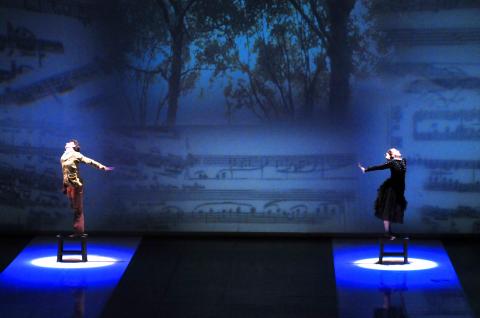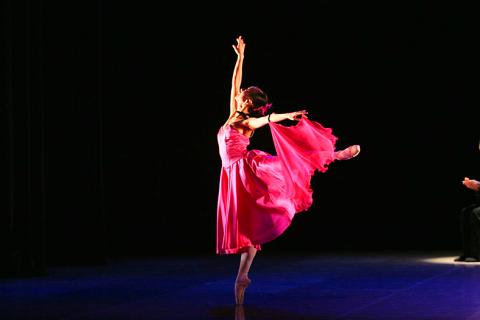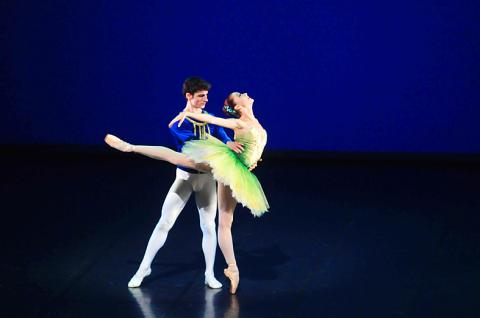Chamber Ballet Taipei’s (台北室內芭蕾舞團) founder and artistic director Allen Yu (余能盛) has returned to his favorite muse for this year’s annual production, Peter Tchaikovsky.
The Austria-based Taiwanese choreographer has frequently said that he loves the 19th-century Russian composer’s music for its combination of romance and sadness, and because it provides him “with limitless imagination.”
That imagination has been put to use in Romance — The Music and The Destiny of Tchaikovsky (羅曼史~柴可夫斯基的音樂與人生), which will be performed in Taipei’s Metropolitan Hall this weekend and in Tainan the following weekend.

Photo courtesy of Chamber Ballet Taipei
To give the full experience of the two Tchaikovsky pieces used in the production, the company will be performing in Taipei with the Taipei Symphony Orchestra (台北市立交響樂團) under the baton of Dutch guest conductor Antony Hermus — who has worked with the company twice before — and with the Taiwan Soloists Symphony Orchestra (台灣獨奏家交響樂團) in Tainan under the baton of Hsiao Pang-hsing (蕭邦享).
The 25-member cast includes two foreign guest artists, both soloists with the Romanian National Ballet.
Although Yu has used Tchaikovsky’s life as the basis of previous productions, such as Tchaikovsky — None But the Lonely Heart and When Ballet Meets Tchaikovsky, in a telephone interview on Monday he said this time he wants to use the music to show the composer’s background, and why he wrote the music that he did.

Photo courtesy of Chamber Ballet Taipei
Yu has read several biographies of the great composer as well as the correspondence between Tchaikovsky and his patron, Nadezhda von Meck, who supported him for 13 years, though on the condition that they never meet.
“His love was a real story. I can’t believe that such a relationship [with von Meck] could exist … Most of his music was for her, in his letters he talked about ‘my pleasure to write this music for you,’” Yu said.
Romance is divided into two parts. The first uses Serenade for Strings in C, Op.48, which has long been a favorite of choreographers such as George Balachine, and the second half is danced to Violin Concerto in D Major,Op.35.

Photo courtesy of Chamber Ballet Taipei
For the serenade section, Yu returns to a metaphor that he has used before on stage — the birdcage, with dancers trapped inside unable to get out.
“There are two couples, one physical and one spiritual,” he said.
For the Violin Concerto Yu changes the perspective to that of the composer himself, given how personal the piece was for Tchaikovsky and what an effect it had on him.

Photo courtesy of Chamber Ballet Taipei
“He only wrote one, no one [violinist] wanted to play it, and there was a lot of criticism when it finally was played. He never wrote another,” Yu said, adding that it was now considered one of the four greatest concertos for the violin ever written.
The violin solo will be performed in Taipei by a young man, Tseng Yu-chien (曾宇謙), who began studying the violin at age three and has won several international competitions. For the Tainan performances, the soloist will be Tsai Cheng-han (蔡承翰).
Yu’s enthusiasm and passion for Tchaikovsky is palpable, even in his program notes for the show.

Photo courtesy of Chamber Ballet Taipei
“By writing the Serenade and Violin Concerto, his music brought people boundless dreams, making choreographers want to use the human body to express that kind of special feeling on the dance stage,” Yu wrote.
While the six-year-old Chamber Ballet only comes together each summer for one production — it is all the time Yu can take away from his main job as deputy ballet director and choreographer at the Opera House in Graz — the shows have been getting stronger each year and Romance holds great promise for another terrific production.

This month the government ordered a one-year block of Xiaohongshu (小紅書) or Rednote, a Chinese social media platform with more than 3 million users in Taiwan. The government pointed to widespread fraud activity on the platform, along with cybersecurity failures. Officials said that they had reached out to the company and asked it to change. However, they received no response. The pro-China parties, the Chinese Nationalist Party (KMT) and Taiwan People’s Party (TPP), immediately swung into action, denouncing the ban as an attack on free speech. This “free speech” claim was then echoed by the People’s Republic of China (PRC),

Exceptions to the rule are sometimes revealing. For a brief few years, there was an emerging ideological split between the Democratic Progressive Party (DPP) and Chinese Nationalist Party (KMT) that appeared to be pushing the DPP in a direction that would be considered more liberal, and the KMT more conservative. In the previous column, “The KMT-DPP’s bureaucrat-led developmental state” (Dec. 11, page 12), we examined how Taiwan’s democratic system developed, and how both the two main parties largely accepted a similar consensus on how Taiwan should be run domestically and did not split along the left-right lines more familiar in

As I finally slid into the warm embrace of the hot, clifftop pool, it was a serene moment of reflection. The sound of the river reflected off the cave walls, the white of our camping lights reflected off the dark, shimmering surface of the water, and I reflected on how fortunate I was to be here. After all, the beautiful walk through narrow canyons that had brought us here had been inaccessible for five years — and will be again soon. The day had started at the Huisun Forest Area (惠蓀林場), at the end of Nantou County Route 80, north and east

Specialty sandwiches loaded with the contents of an entire charcuterie board, overflowing with sauces, creams and all manner of creative add-ons, is perhaps one of the biggest global food trends of this year. From London to New York, lines form down the block for mortadella, burrata, pistachio and more stuffed between slices of fresh sourdough, rye or focaccia. To try the trend in Taipei, Munchies Mafia is for sure the spot — could this be the best sandwich in town? Carlos from Spain and Sergio from Mexico opened this spot just seven months ago. The two met working in the